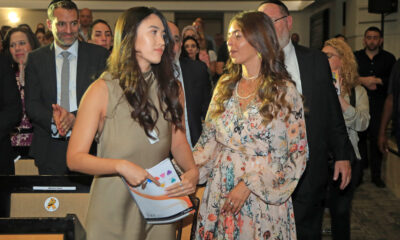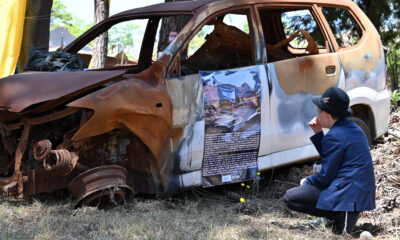
Personal Story

‘We’ll dance again’ – reflecting on the Nova memorial
Fourteen years ago, I walked into the memorial for the Treblinka death camp in Poland. The memorial has stones scattered around a massive field that was used by the Nazis to exterminate thousands of Jews at a time. Each stone carries the name of a Jewish community or shtetl that was annihilated there. It’s quiet and almost peaceful. There were flowers blooming and bees buzzing, and I sat in the grass in shock after reading name after name of town and shtetl. I asked, “How can this place seem so peaceful and beautiful when it’s soaked in Jewish blood?”
Never in my wildest imagination did I think that 14 years later, I would visit a modern-day Treblinka on my home soil, in my country, my Israel. This was what it felt like walking into the Nova Festival Memorial, where more than 300 of my brothers and sisters were massacred on 7 October by the Hamas Nazis.
This time of year, the fields across southern Israel are covered in beautiful wild red anemones. We call it “Darom Adom”. This year, in the wake of the 7 October massacre, “Darom Adom” has taken on a different meaning for Israelis.
As I entered the massive field of the memorial, which lies between Kibbutz Re’im and the Be’eri Forest, wild anemones were blooming, bees were buzzing, and everything was so green, that same question I had 14 years ago, came back to me,
“How can there be such beauty in a place covered in Jewish blood?”
Name after name, picture after picture. It felt never-ending as I walked through the makeshift memorial. Some marking those murdered at the scene, others marking those kidnapped. There are so many names you start to recognise from the news and the stories, like Shani Louk and Alon Werber; those who were kidnapped from the festival like Romi Gonen and Ran Gvili – Ran was later pronounced dead, believed to have been murdered on 7 October. His body is still being held by Hamas in Gaza.
A moment that truly broke me was a tree planted in memory of 22-year-old Rotem Neiman, the small placard standing next to it reading in Hebrew, “With lots of love, dad.”
The scars of that day are still visible all over the festival area, on the bomb shelters covered in bullet holes and explosive marks. One still had blood stains inside, there was dry blood in places on the grass, or on the bottom of a tree.
And yet, there was another heart-wrenching moment during my visit in which soldiers sat on the edge of the memorial playing melancholy songs quietly on their guitars. It was sad and beautiful, but it also gave me a sense of hope.
Months later, it still feels surreal to think that the worst massacre of the Jewish people since the Holocaust happened in our Jewish homeland. How could such a thing have occurred? How can so much Jewish blood be soaked into the holy ground of our country?
The 7 October massacre has touched everything in the south – physically and emotionally. Frankly it’s touched everything across the Jewish world.
The roads and pavements around Otef Aza (the Gaza border communities) still carry indents and marks from explosives and rocket-propelled grenades during the attack. So do the roads to Be’er Sheva, where I live. It’s clear that battles with terrorists happened in certain places as you drive past. Seeing this so close to home, especially when you see signs to “Be’er Sheva” all over the Otef, hit home hard.
In Sderot, tank marks cover the street next to where the police station once stood. It was destroyed during the massacre. What happened in a town I love and know so well is a story for another time. So many stories of pain and heroism took place there, I could fill pages. Stories not so well known include those of mines that the Hamas terrorists placed in the fields around certain areas, including an army base I visited. They’re still working to find all of them. And then there’s just simply walking into an Aroma Cafe at a gas station to pick up coffee, and in the corner, a memorial stands for one of their workers, Chen Ben Avi, who was also murdered at the Nova Festival.
There was one final stop that I made on my visit to Otef, a place that embodies the spirit and resilience of my people: Shuva. During the first few days of the war, many of the victims’ bodies, as well as the injured were brought here. It was the “safest” emergency point closest to where the attacks were taking place. As things “calmed”, three local brothers decided to open a coffee stand here in the hope of “doing something good where so much bad happened”. Today, Shuva has become a 24/7 oasis of calm for Israel Defense Forces soldiers serving in the south and protecting our country. Hot meals, coffee, warm clothes, and more are supplied to soldiers for free. And it’s all run by volunteers. There were even a few soldiers singing and playing guitar, food was being served and again, a sense of hope washed over me.
Though I’m still processing, one thing is clear: in spite of everything – the unbearable pain and trauma we’ve gone through as a people and a nation – we’ll get up dance again. Am Yisrael Chai!
- Ilanit Liberman worked as a reporter for nine years. She now works at an international communications and public relations company.











Choni Davidowitz
February 28, 2024 at 12:54 pm
We’ll dance again! O.K. But not ‘stoned’ on Shmini Atzeret, and not surrounded by ‘strange gods”